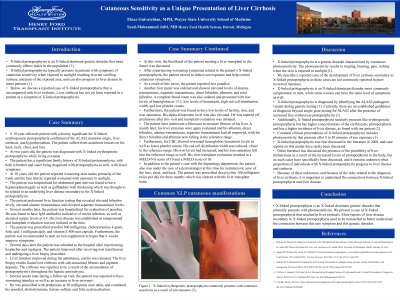Monday Poster Session
Category: Liver
P2504 - Cutaneous Sensitivity as a Unique Presentation of Liver Cirrhosis
Monday, October 23, 2023
10:30 AM - 4:15 PM PT
Location: Exhibit Hall

Has Audio
- EG
Elnaz Guivatchian, MPH
Wayne State University School of Medicine
Detroit, MI
Presenting Author(s)
Elnaz Guivatchian, MPH1, Syed-Mohammed Jafri, MD2
1Wayne State University School of Medicine, Detroit, MI; 2Henry Ford Health System, Detroit, MI
Introduction: We present a unique case of liver cirrhosis and cutaneous sensitivity secondary to X-linked protoporphyria.
Case Description/Methods: An 18-year-old male presents with recurrent acneiform lesions on his back, neck, chest, and face along with a diagnosis of liver cirrhosis. The patient further presents with recurrent jaundice, severe fatigue, and myalgia.
At two years old the patient was diagnosed with X-linked erythropoietic protoporphyria while living overseas, which was later confirmed to be of the ALAS2 mutation origin. The patient has a significant family history of X-linked protoporphyria, with both his brother and sister being diagnosed as well, but with lesser symptoms.
At 18 years old the patient notices worsening cutaneous symptoms with sun exposure. He is hospitalized for abdominal pain and found to have hepatosplenomegaly and gallbladder wall thickening related to an underlying liver disease secondary to his X-linked protoporphyria.
Several months later, the patient is hospitalized for evaluation of jaundice and severe fatigue. Several days later, he is readmitted for headaches and myalgias. The patient undergoes a liver biopsy which shows the accumulation of protoporphyria throughout the liver parenchyma.
Due to further recurrent hospitalizations, the patient moves to the Midwest at 19 years old. Several weeks later the patient undergoes a Fibroscan which shows 35 kPa reflecting cirrhosis. Given the overwhelming fatigue and history of recurrent jaundice, transplant evaluation is initiated. Since the patient had moved to a non-sun-exposed region, however, he did have a progressive improvement in both his skin lesions as well as his fatigue.
Discussion: X-linked protoporphyria is an X-linked dominant genetic disorder that more commonly affects males. X-linked protoporphyria typically presents with symptoms of cutaneous sensitivity when exposed to sunlight resulting in acute swelling, redness, and pain in the exposed area, and can also progress to liver disease in some patients. X-linked protoporphyria similarly presents like erythropoietic protoporphyria but has higher concentrations of erythrocytic protoporphyrin and a higher incidence of liver disease, as found with our patient.
X-linked protoporphyria is diagnosed by identifying the ALAS2 pathogenic variant during genetic testing. Avoidance of sunlight is recommended, and medications will be prescribed to protect liver function. It remains unknown what proportion of individuals with this disorder develop liver disease or cirrhosis.
Disclosures:
Elnaz Guivatchian, MPH1, Syed-Mohammed Jafri, MD2. P2504 - Cutaneous Sensitivity as a Unique Presentation of Liver Cirrhosis, ACG 2023 Annual Scientific Meeting Abstracts. Vancouver, BC, Canada: American College of Gastroenterology.
1Wayne State University School of Medicine, Detroit, MI; 2Henry Ford Health System, Detroit, MI
Introduction: We present a unique case of liver cirrhosis and cutaneous sensitivity secondary to X-linked protoporphyria.
Case Description/Methods: An 18-year-old male presents with recurrent acneiform lesions on his back, neck, chest, and face along with a diagnosis of liver cirrhosis. The patient further presents with recurrent jaundice, severe fatigue, and myalgia.
At two years old the patient was diagnosed with X-linked erythropoietic protoporphyria while living overseas, which was later confirmed to be of the ALAS2 mutation origin. The patient has a significant family history of X-linked protoporphyria, with both his brother and sister being diagnosed as well, but with lesser symptoms.
At 18 years old the patient notices worsening cutaneous symptoms with sun exposure. He is hospitalized for abdominal pain and found to have hepatosplenomegaly and gallbladder wall thickening related to an underlying liver disease secondary to his X-linked protoporphyria.
Several months later, the patient is hospitalized for evaluation of jaundice and severe fatigue. Several days later, he is readmitted for headaches and myalgias. The patient undergoes a liver biopsy which shows the accumulation of protoporphyria throughout the liver parenchyma.
Due to further recurrent hospitalizations, the patient moves to the Midwest at 19 years old. Several weeks later the patient undergoes a Fibroscan which shows 35 kPa reflecting cirrhosis. Given the overwhelming fatigue and history of recurrent jaundice, transplant evaluation is initiated. Since the patient had moved to a non-sun-exposed region, however, he did have a progressive improvement in both his skin lesions as well as his fatigue.
Discussion: X-linked protoporphyria is an X-linked dominant genetic disorder that more commonly affects males. X-linked protoporphyria typically presents with symptoms of cutaneous sensitivity when exposed to sunlight resulting in acute swelling, redness, and pain in the exposed area, and can also progress to liver disease in some patients. X-linked protoporphyria similarly presents like erythropoietic protoporphyria but has higher concentrations of erythrocytic protoporphyrin and a higher incidence of liver disease, as found with our patient.
X-linked protoporphyria is diagnosed by identifying the ALAS2 pathogenic variant during genetic testing. Avoidance of sunlight is recommended, and medications will be prescribed to protect liver function. It remains unknown what proportion of individuals with this disorder develop liver disease or cirrhosis.
Disclosures:
Elnaz Guivatchian indicated no relevant financial relationships.
Syed-Mohammed Jafri: Gilead, Takeda, Abbvie – Advisor or Review Panel Member, Speakers Bureau.
Elnaz Guivatchian, MPH1, Syed-Mohammed Jafri, MD2. P2504 - Cutaneous Sensitivity as a Unique Presentation of Liver Cirrhosis, ACG 2023 Annual Scientific Meeting Abstracts. Vancouver, BC, Canada: American College of Gastroenterology.
